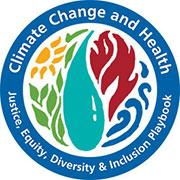 Build meaningful partnerships with local organizations and community leaders.
Build meaningful partnerships with local organizations and community leaders.
Those most negatively impacted by climate change are often also overburdened by other life stressors and health and racial inequities. Public health jurisdictions recognize that addressing fundamental socioeconomic conditions and social determinants of health are critical to improving the health of their communities. Effective action on these conditions requires meaningful engagement with community partners and other stakeholders with shared goals. Working with such a variety of multi-sectoral efforts necessitates networks of engaged thought partners and input from communities with lived experiences.
Multi-organizational and community partnerships and coalitions can be promising mechanisms for improving public health practice. Such partnerships can inform programs, policies and investments to reduce risk and build adaptation resilience, help implement activities on a sufficiently large scale, and contribute to long-term sustainability and effectiveness. Collaborative leadership can leverage the potential gains from partnerships and help organizations commit to beneficial public health actions that cannot be accomplished through independent public health endeavors. The types of partnerships likely to generate the most place-based and sustainable adaptation effects that also strengthen overall population health, are based on deep long term relationships and reciprocity. Public health has always been most effective when communities and partners are aligned and bring their resources to bear on shared goals. When successful, these deep partnerships can serve as vehicles for transforming public health practice from a disjointed collection of programs, activities and organizations into an integrated, holistic public health system. Collaborative leadership can reveal the potential from partnerships and can help organizations and communities commit to difficult but beneficial public health actions that cannot be accomplished through independent endeavors.
For more information on improving multi-organizational partnerships, visit: https://www.cdc.gov/pcd/issues/2010/nov/10_0088.htm.
Assessing JEDI readiness
As relationships are built with trusted partners and community leaders, it is critical to reflect regularly and thoughtfully on the core tenants of JEDI to ensure that critical representation and voices are at the decision-making table. Asking these questions can help guide your efforts.
| KEY JEDI QUESTIONS |
|
| Justice |
Has everyone been meaningfully involved? |
| Equity |
Who is trying to get into the room but can't? |
| Diversity |
Who is in the room? |
| Inclusion |
Have everyone's ideas been heard? |
Adapted from Diversity Labs
Evaluate your department’s capacity, readiness and timeline.
The following checklist offers a guide to a successful planning effort.
- Become familiar with the BRACE framework.
- Become familiar with the JEDI implications at the local level, and examples of successful adaptation planning efforts that are centered on JEDI and social determinants of health.
- Assess your jurisdiction’s prior experience with climate mitigation and adaptation planning. If possible, participate in direct peer exchange with similar jurisdictions to learn best practices.
- Identify and engage key partners, including community members and key stakeholders.
- Understand the resources available and potential limitations on data and expertise. For example, some staff and partners may lack expertise in community and stakeholder engagement, climate and health research, epidemiology and data analysis that the BRACE model requires.
- Define the scope of the plan and the timeline for implementation, monitoring, iterative planning and evaluation.
- Prioritize and select interventions based on community driven solutions to address capacity, resources, community input, and the time frame for the plan. Create support for rural and resource-limited jurisdictions and regions.
- Create communication strategies to bring a diverse set of partners into the conversation of adaptation planning. Develop and invite compelling stories for trainings and presentations that generate empathy and understanding around key messages of climate change, health and equity.
Resources
The following may be especially helpful in guiding health practitioners, health departments, climate-focused organizations and policymakers in developing best practices for mitigating the impacts of climate change.